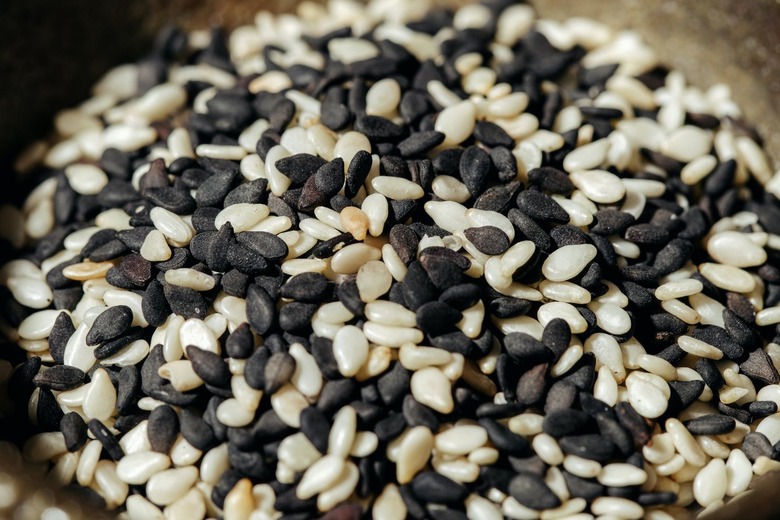7 Facts About Sesame That Will Blow Your Mind
If you're like me, your kitchen cabinet is stocked with fragrant sesame oil and black sesame seeds. I use the oil for its distinctive aroma in cooking savory dishes, and I sprinkle the seeds on both stir-fries and salads to add a crunchy, nutty taste. Plus, I recently learned that this tiny seed has an intriguing history and powerful properties, so I did a deep dive to discover some surprising facts about sesame.
1. Sesame is the oldest oilseed crop.
1. Sesame is the oldest oilseed crop.
According to researchers at Purdue University, the sesame crop is thought to have originated in Africa. The journal Economic Botany reports that the seed was later domesticated on the Indian subcontinent during 3050-3500 B.C. The ancient Vedic scriptures also contain frequent references to sesame. Farmers grew the seed in the Armenian city Karmir Blur in 600 B.C., and in South Arabia's Hajar Bin Humeid in 450 B.C. Later, sesame became an agricultural staple in Urartu, a northern neighbor of Mesopotamia in 6 B.C. Records suggest sesame reached China and Egypt around 3 B.C. It was even used in the mummification process as an antiseptic, according to The Scientific Study of Mummies by Arthur C. Aufderheide.
2. Sesame has many bodily benefits.
2. Sesame has many bodily benefits.
It's not a surprise that, like other seeds, sesame is also good for you. According to Pharmacognosy Review, several studies report on sesame's antioxidant and anti-carcinogenic properties. Plus, besides lowering cholesterol levels and preventing high blood pressure, consuming sesame is good for the liver, cardiovascular functions, and tumor prevention. Sesame seeds are also high in vitamin B1 and are an excellent source of phosphorus. They contain iron, protein, magnesium, calcium, manganese, copper, and zinc, too.
3. There are different varieties of sesame with unique properties.
3. There are different varieties of sesame with unique properties.
White sesame has the subtlest flavor by far, according to Umami Insider, and is the most popular of the varieties in Japanese cuisine. It is often used in salad dressing and as a garnish for many dishes.
The flavor of black sesame is distinctively robust and nutty. People use the seed to make cookies, ice cream, pastries, and other desserts. It also shows up in marinades, as a garnish, or crushed to make a savory paste. According to the journal Molecules, black sesame seeds are anti-inflammatory, anti-tumor, and anti-cancer, with loads of anti-aging properties.
Golden sesame seeds are found in furikake, a Japanese seasoning containing nori seaweed. Furikake is mainly used to season white rice, but it can be added to many dishes.
The vibrant red-brown sesame provides a sweet aroma as well as a nutty flavor. According to Pharmacognosy Review, brown sesame has a high level of phytosterol, a compound that lowers cholesterol levels.
4. Sesame can trigger allergic reactions in some people.
4. Sesame can trigger allergic reactions in some people.
Like other nuts and seeds, sesame can be an allergenic food. The National Institute of Health reports that the prevalence of a sesame allergy is about 0.23% in the United States. It is considered one of the top 10 most common allergens, affecting 1.1 million people. An estimated 17% of all food-allergic children also have a sesame allergy, although some grow out of it.
5. The sesame plant is drought-resistant.
5. The sesame plant is drought-resistant.
Even as the earth keeps heating up, we won't have to worry too much about the fate of sesame. It grows well in hot, dry conditions, and according to Plant Biotechnol Journal, unlike most important food crops, this plant can withstand drought. This is good news because sesame farmers can expect stable yields in drought-prone areas.
6. Sesame has advantages in non-food products.
6. Sesame has advantages in non-food products.
Sesame is a popular natural ingredient in cosmetics, reports Cosmetics Info. Because of its moisture-retaining properties, HowStuffWorks reveals that sesame oil has a unique ability to soften skin and hair. If you have a habit of reading product labels, you've most likely come across the oil listed in soap, lotion, hair products, and lipstick labels.
Sesame was also used in ancient oil lamps and, per Forest Essentials, people still light the oil for ceremonies. The press cake (or oil cake) — referring to the solids left over after something has been pressed to extract liquid — has a curious application: It's used as a nutritious livestock meal that increases vitamin E in animals, according to Economic Botany.
7. You can easily make your own sesame oil.
7. You can easily make your own sesame oil.
The DIY recipe to make your own sesame oil is rather straightforward. It involves toasting the seeds and then blending, steeping, and straining the resulting paste. A kilogram of sesame should yield about half a liter of oil.
